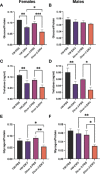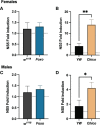Zika Virus Induces Sex-Dependent Metabolic Changes in Drosophila melanogaster to Promote Viral Replication
- PMID: 35844546
- PMCID: PMC9280044
- DOI: 10.3389/fimmu.2022.903860
Zika Virus Induces Sex-Dependent Metabolic Changes in Drosophila melanogaster to Promote Viral Replication
Abstract
Zika is a member of the Flaviviridae virus family that poses some of the most significant global health risks, causing neurologic complications that range from sensory neuropathy and seizures to congenital Zika syndrome (microcephaly) in infants born to mothers infected during pregnancy. The recent outbreak of Zika virus (ZIKV) and its serious health threats calls for the characterization and understanding of Zika pathogenesis, as well as host antiviral immune functions. Although ZIKV has been associated with activating the RNA interference (RNAi) immune pathway and altering host metabolism, in-depth studies are still required to uncover the specifics of the complex host-virus interactions and provide additional insights into the molecular components that determine the outcome of this disease. Previous research establishes the fruit fly Drosophila melanogaster as a reliable model for studying viral pathogens, as it shares significant similarities with that of vertebrate animal systems. Here, we have developed an in vivo Drosophila model to investigate ZIKV-mediated perturbed metabolism in correlation to the RNAi central mediator Dicer-2. We report that ZIKV infection reprograms glucose and glycogen metabolism in Dicer-2 mutants to maintain efficient replication and successful propagation. Flies that exhibit these metabolic effects also show reduced food intake, which highlights the complicated neurological defects associated with ZIKV. We show that ZIKV infection significantly reduces insulin gene expression in Dicer-2 mutants, suggesting an insulin antiviral role against ZIKV and a direct connection to RNAi immunity. Moreover, we find that the insulin receptor substrate chico is crucial to the survival of ZIKV-infected flies. These observations are remarkably more severe in adult female flies compared to males, indicating possible sex differences in the rates of infection and susceptibility to the development of disease. Such findings not only demonstrate that metabolic alterations can be potentially exploited for developing immune therapeutic strategies but also that preventive measures for disease development may require sex-specific approaches. Therefore, further studies are urgently needed to explore the molecular factors that could be considered as targets to inhibit ZIKV manipulation of host cell metabolism in females and males.
Keywords: Drosophila; RNA interference; Zika virus; innate immunity; metabolism.
Copyright © 2022 Tafesh-Edwards, Kalukin and Eleftherianos.
Conflict of interest statement
The authors declare that the research was conducted in the absence of any commercial or financial relationships that could be construed as a potential conflict of interest.
Figures







Similar articles
-
Dicer-2 Regulates Resistance and Maintains Homeostasis against Zika Virus Infection in Drosophila.J Immunol. 2018 Nov 15;201(10):3058-3072. doi: 10.4049/jimmunol.1800597. Epub 2018 Oct 10. J Immunol. 2018. PMID: 30305326 Free PMC article.
-
Inflammatory-dependent Sting activation induces antiviral autophagy to limit zika virus in the Drosophila brain.Autophagy. 2019 Jan;15(1):1-3. doi: 10.1080/15548627.2018.1539585. Epub 2018 Nov 1. Autophagy. 2019. PMID: 30354937 Free PMC article.
-
A Zika virus protein expression screen in Drosophila to investigate targeted host pathways during development.Dis Model Mech. 2024 Feb 1;17(2):dmm050297. doi: 10.1242/dmm.050297. Epub 2024 Feb 28. Dis Model Mech. 2024. PMID: 38214058 Free PMC article.
-
Zika Virus: Recent Advances towards the Development of Vaccines and Therapeutics.Viruses. 2017 Jun 13;9(6):143. doi: 10.3390/v9060143. Viruses. 2017. PMID: 28608813 Free PMC article. Review.
-
Hide and Seek: The Interplay Between Zika Virus and the Host Immune Response.Front Immunol. 2021 Oct 21;12:750365. doi: 10.3389/fimmu.2021.750365. eCollection 2021. Front Immunol. 2021. PMID: 34745123 Free PMC article. Review.
Cited by
-
Wolbachia endosymbionts in Drosophila regulate the resistance to Zika virus infection in a sex dependent manner.Front Microbiol. 2024 Jun 5;15:1380647. doi: 10.3389/fmicb.2024.1380647. eCollection 2024. Front Microbiol. 2024. PMID: 38903791 Free PMC article.
-
Temperature and sex shape Zika virus pathogenicity in the adult Brat cheesehead brain: A Drosophila model for virus-associated neurological diseases.iScience. 2023 Mar 16;26(4):106424. doi: 10.1016/j.isci.2023.106424. eCollection 2023 Apr 21. iScience. 2023. PMID: 37009222 Free PMC article.
-
Integrated control strategies for dengue, Zika, and Chikungunya virus infections.Front Immunol. 2023 Dec 18;14:1281667. doi: 10.3389/fimmu.2023.1281667. eCollection 2023. Front Immunol. 2023. PMID: 38196945 Free PMC article. Review.
References
-
- Sasi MS, Rajendran R, Meenakshy V, Suresh T, Heera Pillai R, Dilip Kumar T, et al. . Study on Vector Dynamics of Zika Virus Outbreak in Thiruvananthapuram, Kerala, India. Int J Curr Microbiol App Sci (2021) 10:54–71. doi: 10.20546/ijcmas.2021.1012.008 - DOI
-
- Martins MM, Alves da Cunha AJL, Robaina JR, Raymundo CE, Barbosa AP, Medronho RA. Fetal, Neonatal, and Infant Outcomes Associated With Maternal Zika Virus Infection During Pregnancy: A Systematic Review and Meta-Analysis. PLoS One (2021) 16:e0246643. doi: 10.1371/journal.pone.0246643 - DOI - PMC - PubMed
MeSH terms
Substances
Grants and funding
LinkOut - more resources
Full Text Sources
Medical
Molecular Biology Databases

